Family : Viperidae

Text © Dr. Luca Tringali

English translation by Mario Beltramini
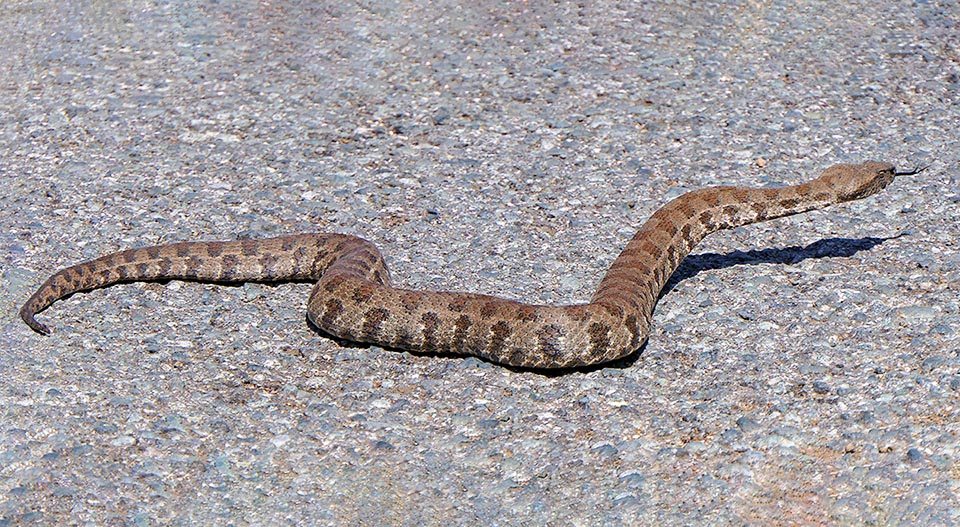
Macrovipera lebetinus lebetinus is the nominal subspecies endemic to Cyprus, even 230 cm long with 2700 g of weight © Luca Tringali
The Levant viper or Blunt-nosed viper, Macrovipera lebetinus (Linnaeus, 1758 is a snake belonging to the family of the Viperidae and to the subfamily Viperinae that includes about 100 venomous species belonging to 12 genera. The oldest fossils date back to the Early Miocene, 23,3-16,3 million years ago, however recent investigations suggest an origin dating back to about 50 million years. Presently the viperids of the Palearctic region are present in a great variety of habitats, from North Africa to the Arctic Circle, and from Great Britain to the Pacific coasts of Asia where they occupy different ecological niches.
The generic name Macrovipera comes from the fusion of the Greek term “μακρός” (macrós), long, broad, and from the word viper, contraction of viviparous, that gives birth to fully formed babies, from the Latin “vivus”, alive, and “parere”, to deliver. Conversely, two different interpretations of the specific epithet lebetinus do exist: the most immediate refers to its geographical distribution, and comes from Levantine, oriental; the second etymology comes from the Greek “λέβης” (lébes), vessel used in the purification ceremonies such as sacrifices and funerals, alluding to the dangerousness of this snake.
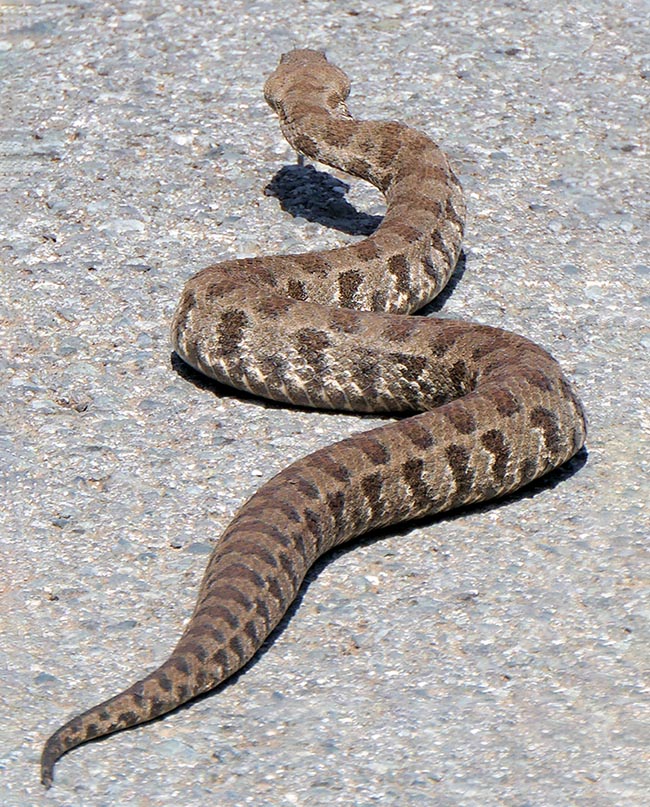
The body is stocky with the tail tapering sharply, especially in the males © Luca Tringali
Zoogeography
Iranian-Turanian Palearctic species, it has a vast distribution range going from Turkey and Cyprus, through the Middle East and Central Asia up to the Tajik-Chinese border, western Pakistan and India (Kashmir).
While the taxonomy and distribution in the central western range are fairly well known, teh same cannot be said about the eastern part of its distribution range, as well as for what concerns the subspecific status of those populations.
The most recent phylogenetic analyses confirm the validity of four subspecies:
Macrovipera lebetinus lebetinus (Linnaeus, 1758): nominal subspecies endemic to Cyprus;
Macrovipera lebetinus cernovi (Chikin & Szczerbak, 1992): present in Turkmenistan, Iran, Uzbekistan, Kyrgyzstan, Afghanistan, India (Kashmir), Pakistan;
Macrovipera lebetinus obtusa (Dwigubsky, 1832): diffused in Turkey, Georgia, Armenia, Azerbaijan, Iraq, Afghanistan, Syria, Lebanon, Jordan, Iran, Pakistan;
Macrovipera lebetinus turanica (Chernov, 1939): present in Tajikistan, Uzbekistan, Kyrgyzstan.
Ecology-Habitat
Macrovipera lebetinus is a species with excellent ability to adapt and able to withstand wide environmental variations. It frequents a huge variety of environments that include natural rocky areas, semiarid, forests, meadows, and anthropized areas like orchards, vineyards, cultivations, pastures, gardens, ruins, landfills, from the sea level up to 2500 m of altitude, preferably near the water where, well camouflaged, waits for the potential prey going there to drink.
Morphophysiology
Immediately identifiable in its distribution area due to its size, the nominal subspecies Macrovipera lebetinus lebetinus has 126-158 ventral scales, 39-46 subcaudal, 25 rows of scales.
This large and robust species, that may reach the length of 230 cm and a weight of 2700 g, has a triangular head that seems to be rounded if viewed from above.
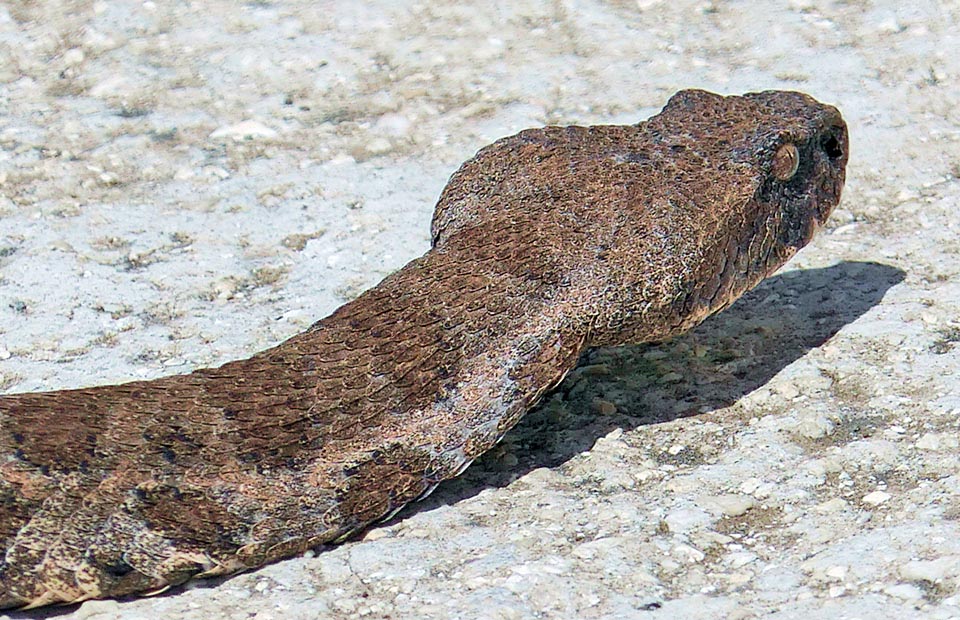
Prominent supraocular crests confer a threatening look, whilst the bumps behind the eyes highlight the big venom glands © Luca Tringali
Two prominent supraocular crests confer to the Levant viper a rather threatening look, whilst the two bumps just behind the eyes correspond to the venom glands that may contain up to 15 ml of venom.
It has a heavy and stocky body with a tail that tapers sharply and that, being rather longer in the females, reveals to be a reliable character for distinguishing the two sexes.
The background colour varies from grey, to beige, to rust, and is subject to variations during the year being usually paler in summer.
Like all viperids, it is a solenoglyphous snake, from the Latin “solen”, tube, and from the Greek verb “γλύϕω” (glifo), to engrave, with reference to the tubular, canaliculate teeth located in the front part of the maxilla.
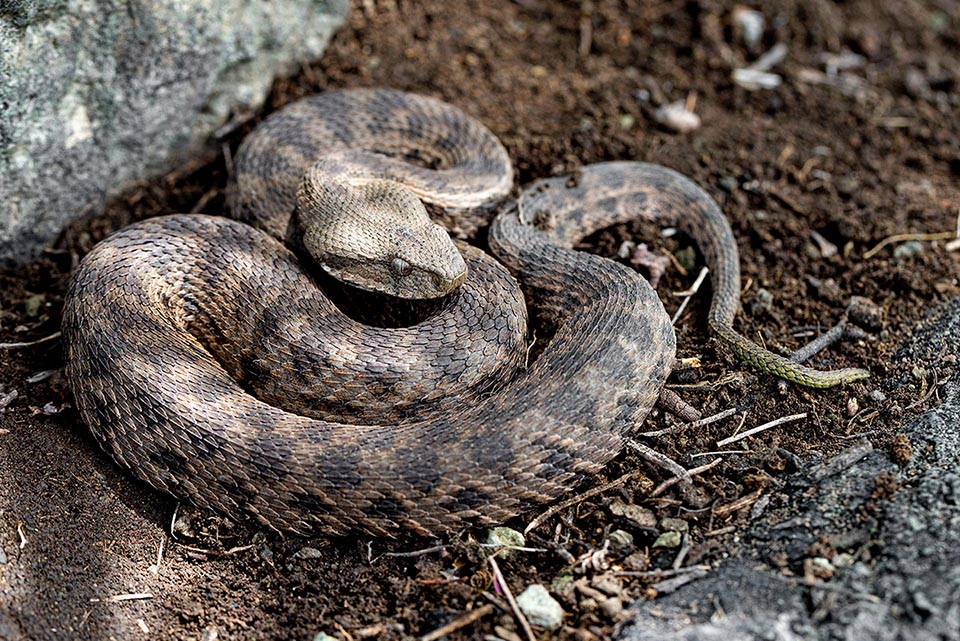
Macrovipera lebetinus obtusa is the most diffused species, present in Turkey, Georgia, Armenia, Azerbaijan, Iraq, Afghanistan, Syria, Lebanon, Jordan, Iran and Pakistan © Lennart Schmid
Its venom is essentially made up of hemotoxins that break down the blood and the muscular tissues, and of cytotoxins that cause the necrosis of the cells.
If the fatal dose of the venom of this species is of 0,64 mg of dry substance per kg of weight of the victim, it is easy to understand how dangerous is this reptile able to produce 12-150 mg of toxic substance.
The injected quantity of venom, combined with its toxicity, render the bite of the Levant viper highly dangerous, even if the ascertained human human deaths are few, also considering the slow efficacy of the venom that allows the victim to seek medical care.
Ethology-Reproductive Biology
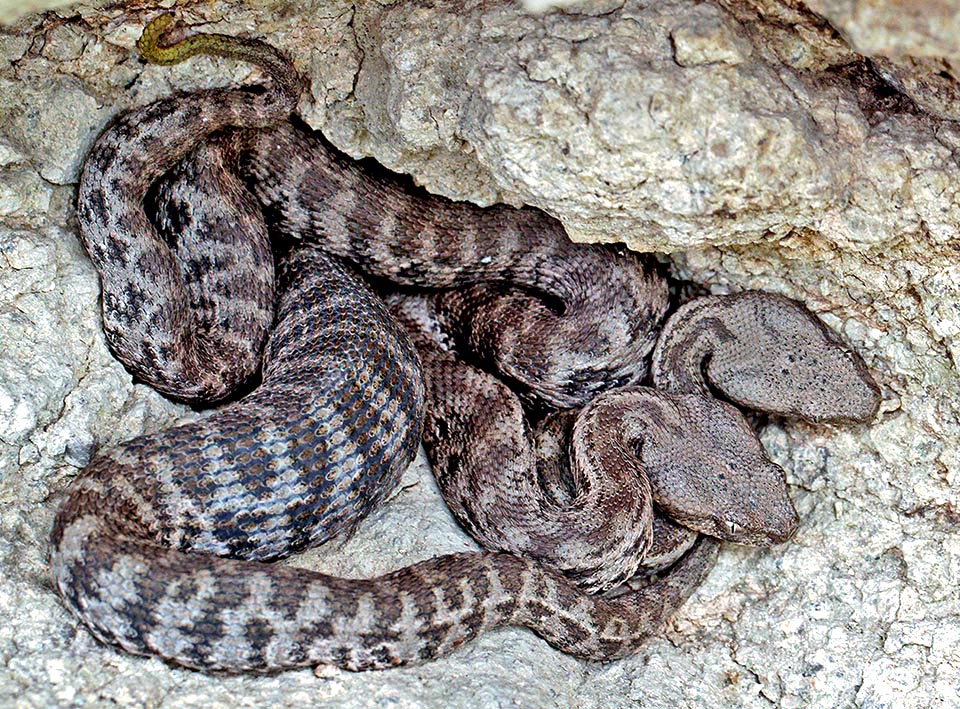
Here two females of Macrovipera lebetinus obtusa wake up after the winter hibernation. Diurnal in the cooler months, in summer has generally crepuscular and night habits © Dan Rosenberg
Species once deemed ovoviviparous, as well as the rest of the other viperids, after some observations in captivity, Macrovipera lebetinus has turned out to be oviparous.
In the nominal subspecies mating occurs between mid April and mid June, and the female lays averagely 14 white oval eggs, that hatch after about 30 days giving birth to perfectly formed and autonomous babies, with a venom as strong as the one of the adults.
Diurnal in the cooler months, in summer has crepuscular and nocturnal habits, whilst the cold winter months are spent in hibernation. The adults hunt preferably mammals of the genera Rattus, Mus, Lepus, birds like Passer, Carduelis, Saxicola, Egretta, Alectoris and other snakes. The juveniles have a diet formed by insects, small rodents and lacertids.
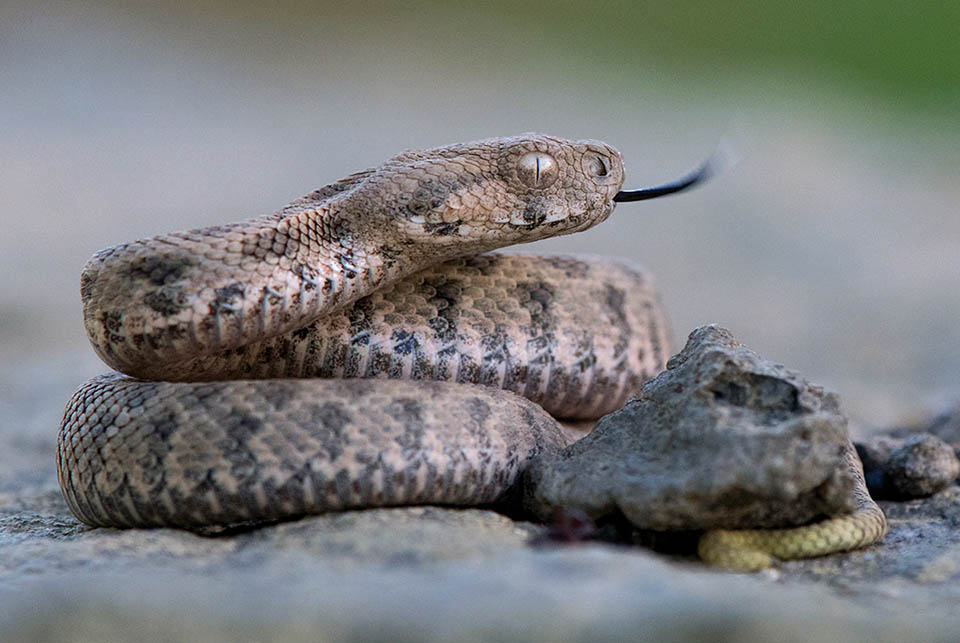
Like in all ophidians, the tongue serves to collect information from the environment. The pupils, vertical the day, round up and get bigger the night to improve vision © Maxime Briola
Heavy and relatively slow snake, when it has to inflict a bite for seizing the prey, springs in a surprisingly quick way, about 73 milliseconds between the start of the attack and the bite.
The terrestrial preys are released just after the bite, followed and detected through the smell and then swallowed from the head once dead. With the birds this viper adopts a different attack strategy: repeatedly it strikes the prey to prevent it from flying away and to die beyond its reach.
The injected venom, in addition to immobilizing and killing the prey, also carries out an important digestive function.
Rather shy reptile, it is never aggressive towards humans. Just for its characteristic of hiding and of being particularly cryptic, difficult to detect even for a trained eye, it is rightly the cause of the accidents happening every year.
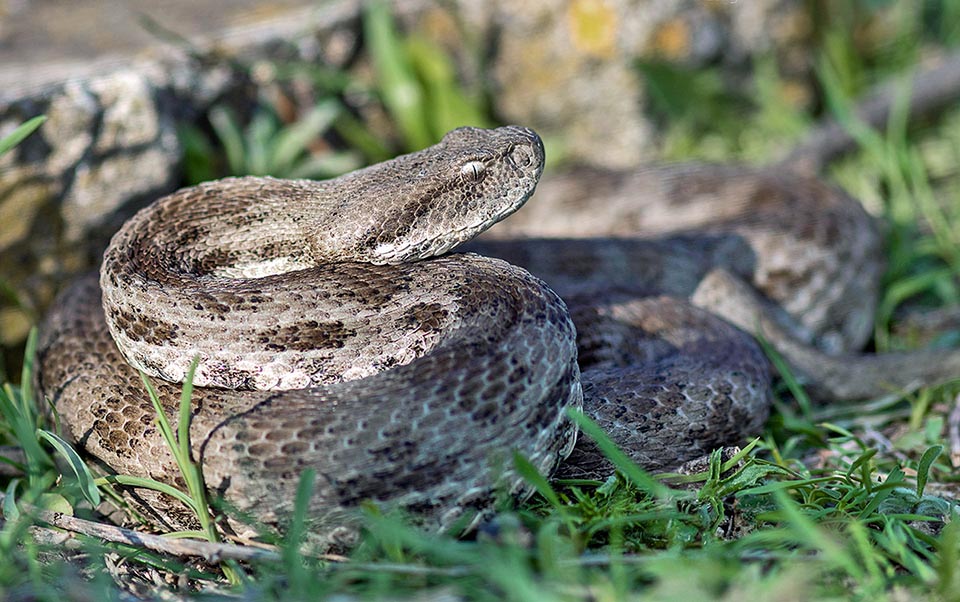
Quite shy reptile, Macrovipera lebetinus is never aggressive towards humans but unfortunately frequents also anthropized areas © Frank Deschandol
When near a human being it usually keeps motionless and does not show any reaction, unless it gets too close or, what is worse, inadvertently stepped on. Moreover, the possibility of dangerous encounters for man, is favoured by the habit of Macrovipera lebetinus to frequent anthropized areas where it looks for prey or for water during the warmest periods.
The populations of Macrovipera lebetinus, recently classified “LC, Least Concern” in the IUCN Red List, are recording a trend to the decrease in the number of individuals, especially due to the ever-increasing number of killings due to the car traffic as well as by shepherds and countrymen.
Synonyms
Coluber lebetinus Linnaeus, 1758; Vipera lebetina Daudin, 1803; Vipera euphratica Martin, 1838; Daboia lebetina Engelmann et al, 1993; Daboia euphratica Gray, 1849 Macrovipera lebetina McDiarmid, Campbell & Touré, 1999.
→ For general notions about Serpentes please click here.
→ To appreciate the biodiversity within the SNAKES please click here.
